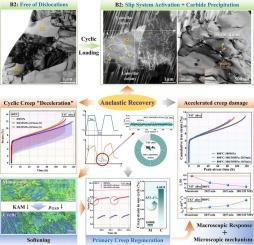Experimental investigation on anelasticity-controlled cyclic creep behavior in multiscale hybrid-reinforced TiAl alloys
IF 6.8
2区 材料科学
Q1 ENGINEERING, MECHANICAL
引用次数: 0
Abstract
As hot-end components in aero-engines, TiAl alloys are expected to experience cyclic creep in service. In this work, hybrid-reinforced TiAl alloys with superior creep resistance were developed through synergistic micro-alloying of C and Y2O3 combined with long-term annealing. Monotonic and cyclic creep tests under various loading conditions were conducted to specifically investigate the cyclic creep behavior of the hybrid-reinforced TiAl alloys. The results indicate that, compared with monotonic creep, cyclic creep exhibits a longer rupture life and a lower strain rate due to anelastic recovery. However, the introduction of cyclic loading enhances the intrinsic creep deformation capacity of TiAl alloys due to primary creep regeneration effect, and accelerates the intrinsic creep damage, resulting in a shorter creep endurance life. Two dominant anelastic recovery mechanisms associated with dislocation cells and dislocation pile-ups were revealed. Moreover, the presence of hybrid reinforcements enhances the anelastic recovery extent. The effects of various loading parameters, including the peak stress dwell time, stress ratio, and temperature, on the macroscopic cyclic creep response were clarified. The microscopic cyclic creep deformation and failure mechanisms, as well as the dynamic precipitation behavior of Ti2AlC within the B2 phase were elucidated. A comprehensive understanding of cyclic creep behavior from both macroscopic and microscopic perspectives will help advance the structural integrity assessment of TiAl alloys.

多尺度混杂增强TiAl合金无弹性控制循环蠕变行为的实验研究
作为航空发动机的热端部件,TiAl合金在使用过程中会经历循环蠕变。本研究通过C和Y2O3协同微合金化并结合长期退火,制备了具有优异抗蠕变性能的混合增强TiAl合金。通过不同加载条件下的单调蠕变和循环蠕变试验,研究了混合增强TiAl合金的循环蠕变行为。结果表明,与单调蠕变相比,循环蠕变具有较长的断裂寿命和较低的应变速率。而循环加载的引入,由于初蠕变再生效应,增强了TiAl合金的本征蠕变变形能力,加速了本征蠕变损伤,导致TiAl合金的蠕变耐久寿命缩短。揭示了与位错细胞和位错堆积相关的两种主要的非弹性恢复机制。此外,混杂增强材料的存在提高了材料的非弹性恢复程度。阐明了峰值应力停留时间、应力比、温度等不同加载参数对宏观循环蠕变响应的影响。研究了Ti2AlC在B2相中的微观循环蠕变变形破坏机制和动态析出行为。从宏观和微观两方面对循环蠕变行为的全面理解将有助于推进TiAl合金的结构完整性评估。
本文章由计算机程序翻译,如有差异,请以英文原文为准。
求助全文
约1分钟内获得全文
求助全文
来源期刊

International Journal of Fatigue
工程技术-材料科学:综合
CiteScore
10.70
自引率
21.70%
发文量
619
审稿时长
58 days
期刊介绍:
Typical subjects discussed in International Journal of Fatigue address:
Novel fatigue testing and characterization methods (new kinds of fatigue tests, critical evaluation of existing methods, in situ measurement of fatigue degradation, non-contact field measurements)
Multiaxial fatigue and complex loading effects of materials and structures, exploring state-of-the-art concepts in degradation under cyclic loading
Fatigue in the very high cycle regime, including failure mode transitions from surface to subsurface, effects of surface treatment, processing, and loading conditions
Modeling (including degradation processes and related driving forces, multiscale/multi-resolution methods, computational hierarchical and concurrent methods for coupled component and material responses, novel methods for notch root analysis, fracture mechanics, damage mechanics, crack growth kinetics, life prediction and durability, and prediction of stochastic fatigue behavior reflecting microstructure and service conditions)
Models for early stages of fatigue crack formation and growth that explicitly consider microstructure and relevant materials science aspects
Understanding the influence or manufacturing and processing route on fatigue degradation, and embedding this understanding in more predictive schemes for mitigation and design against fatigue
Prognosis and damage state awareness (including sensors, monitoring, methodology, interactive control, accelerated methods, data interpretation)
Applications of technologies associated with fatigue and their implications for structural integrity and reliability. This includes issues related to design, operation and maintenance, i.e., life cycle engineering
Smart materials and structures that can sense and mitigate fatigue degradation
Fatigue of devices and structures at small scales, including effects of process route and surfaces/interfaces.
 求助内容:
求助内容: 应助结果提醒方式:
应助结果提醒方式:


